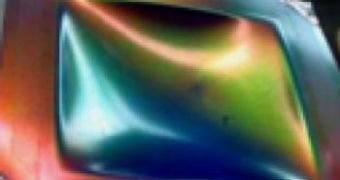A new color-changing technology could have many practical applications, from letting you know if your dollar bill is counterfeit simply by stretching it to see if it changes hue, to showing you what food in your fridge is spoiled.
Developed by scientists at the University of Southampton in the United Kingdom and the Deutsches Kunststoff-Institut (DKI) in Darmstadt, Germany, the new polymer opal films are a class of photonic crystals that change color in various chemical conditions, thus pointing to unwanted changes in the structure of some materials.
They are built of numerous small repeating units and are usually associated with a large contrast in the optical properties of the components, leading to a range of frequencies, called a "photonic bandgap," where light cannot propagate in any directions.
The self-assembling material is a flexible polymer plastic film that scatters light in specific ways, according to irregularities in the film that strongly affect the way the light travels through them, much like the opal gem stones seem to bend light rays.
The photonic crystals could have various uses in many industry areas and this new material could very well do that due to a complex interplay between the order and the irregularity in its structure, forcing light to behave differently.
By doing that, various colors appear on the surface, which could indicate that something has changed in the properties of the original material, very useful in detecting counterfeit bills and altered food.
"The polymer opal films are made of arrays of spheres stacked in three dimensions, rather than layers. They also contain tiny carbon nanoparticles wedged between the spheres, so light doesn't just reflect at the interfaces between the plastic spheres and the surrounding materials, it also scatters off the nanoparticles embedded between the spheres," explains Jeremy J. Baumberg, leader of the team that created the new material.
"This makes the film intensely colored, even though they are made from only transparent and black components, which are environmentally benign. Additionally, the material can be 'tuned' to only scatter certain frequencies of light simply by making the spheres larger or smaller."
A few problems still need to be solved before this tunability could be harnessed in commercial and defense applications, but researchers hope to do this in the shortest time possible.

 14 DAY TRIAL //
14 DAY TRIAL //